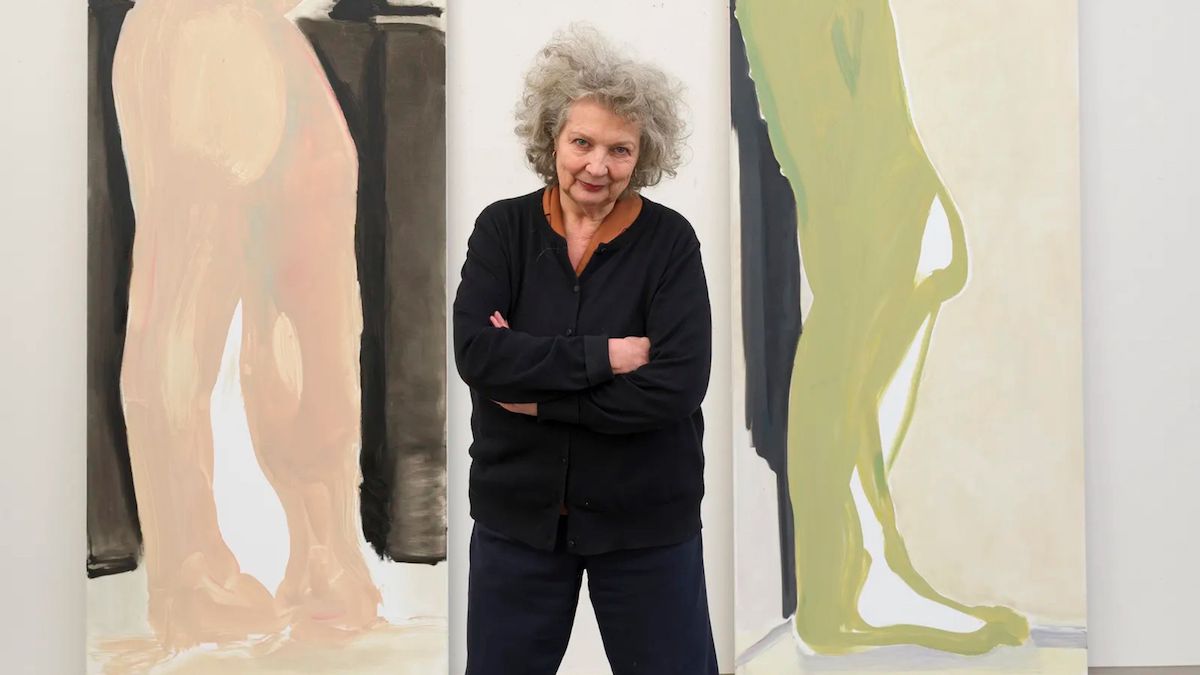It’s the kind of milestone that feels both overdue and oddly inevitable. The Louvre — that great cathedral of art history, where centuries of male genius stare solemnly down from gilded frames — has made way for Marlene Dumas. The Dutch–South African painter, now 71, has become the first contemporary woman artist to join the museum’s permanent collection. Nine of her works, from the haunting Liaisons series, are now hanging on the ground floor of the Denon Wing, just above the Seine.
Dumas, whose portraits and figures seem to blur the lines between visibility and erasure, is no stranger to shaking institutions. Her paintings — never pretty, always alive — have long challenged the notion of depicting the human condition without sentimentality. In Liaisons, faces are built out of smudges and stains: pine green melting into orange, a cheek dissolving into blue, each gaze both intimate and remote. They are paintings that look back at you, and not kindly.
“It’s a battle, always,” Dumas told Le Monde. “Painting means wrestling with yourself, with the materials, with time. There’s no guarantee of success.” It’s this friction — between empathy and estrangement, flesh and image — that makes her work feel so piercing in a museum built on idealised bodies.
The Louvre’s acquisition comes at a tense time for the institution. President Laurence des Cars, who commissioned Dumas for the collection, has made diversification a cornerstone of her leadership — modernising the museum’s holdings while maintaining its public aura of permanence. Yet the October theft of the crown jewels and revelations about lapses in security have placed every new initiative under scrutiny. It’s an uneasy moment to celebrate an act of progress, but perhaps that makes the gesture more meaningful.
Still, this is a historic correction. For all its global prestige, the Louvre has been slow to acknowledge living women artists, let alone those working in a contemporary idiom. Dumas’s inclusion signals something bolder — that the museum can, at last, see the present tense as part of its story.
Born in Cape Town in 1953 under apartheid, Dumas left South Africa in the 1970s to study in Amsterdam, where she has lived since. Her own life — marked by migration, displacement, and moral turbulence — seeps into her paintings. She often paints from photographs: news images, film stills, snapshots of lovers, Polaroids of friends. The act of translating these mediated images into paint is, for her, political — a way to make contact across the distance that photography creates. “Painting,” she has said, “is the trace of the human touch.”
Her subjects range from saints to porn stars, newborns to corpses. In works like Chlorosis (Love Sick) (1994), faces glow in sickly shades of green — a sort of visual fever dream. Her women cry, stare, sleep, seduce, disintegrate. Some seem half-formed, as if still deciding whether to appear at all. There’s always a sense that something is leaking — colour, meaning, life itself.
Earlier this year, Dumas became the most expensive living female artist when Miss January (1997), a half-nude rendered in her signature wash of ambiguity, sold for $13.6 million at Christie’s. The art market, predictably, framed it as a triumph of commerce. However, Dumas has never painted for the market. Her work has always been about the body as a site of contradiction — tender, grotesque, erotic, wounded. “I do treat my faces with a certain equality,” she once said. “They are all the same and yet never alike.”
Her process, too, carries a kind of raw poetry. Dumas tilts her paper or canvas to let the pigment run, using gravity itself to find form. It’s a physical act of surrender — of letting the paint decide what a face becomes. That transparency, literal and metaphorical, mirrors the fragile line between revealing and concealing.
Over the decades, Dumas has exhibited at every central international stage — four Venice Biennales, two Documentas, retrospectives at MoMA and the Tate. Yet her paintings retain the intimacy of a private confession. Even when blown up to monumental scale, they whisper rather than shout.
The Louvre’s embrace of Dumas, then, feels symbolic — not of token inclusion, but of a shift in what the museum imagines itself to be. The artist’s Liaisons series now sits, quite literally, in dialogue with history’s ghosts. Around the corner are Delacroix and Ingres, men who defined how emotion and form could merge. Dumas, with her bruised hues and blurred edges, continues that lineage — but she paints from the inside out.
There’s irony, too, in the fact that Dumas, whose work often questions power and beauty, now hangs in the temple of both. Yet maybe that’s the point. For all its marble and grandeur, the Louvre remains, at heart, a place where artists wrestle with immortality. Dumas, who has always painted as if time were already slipping away, fits right in.
It’s a sign that even the oldest institutions can blink, briefly, and recognise the living.
Marlene Dumas (Image credit: Photography: Peter Cox, Eindhoven. Copyright: Marlene Dumas)

